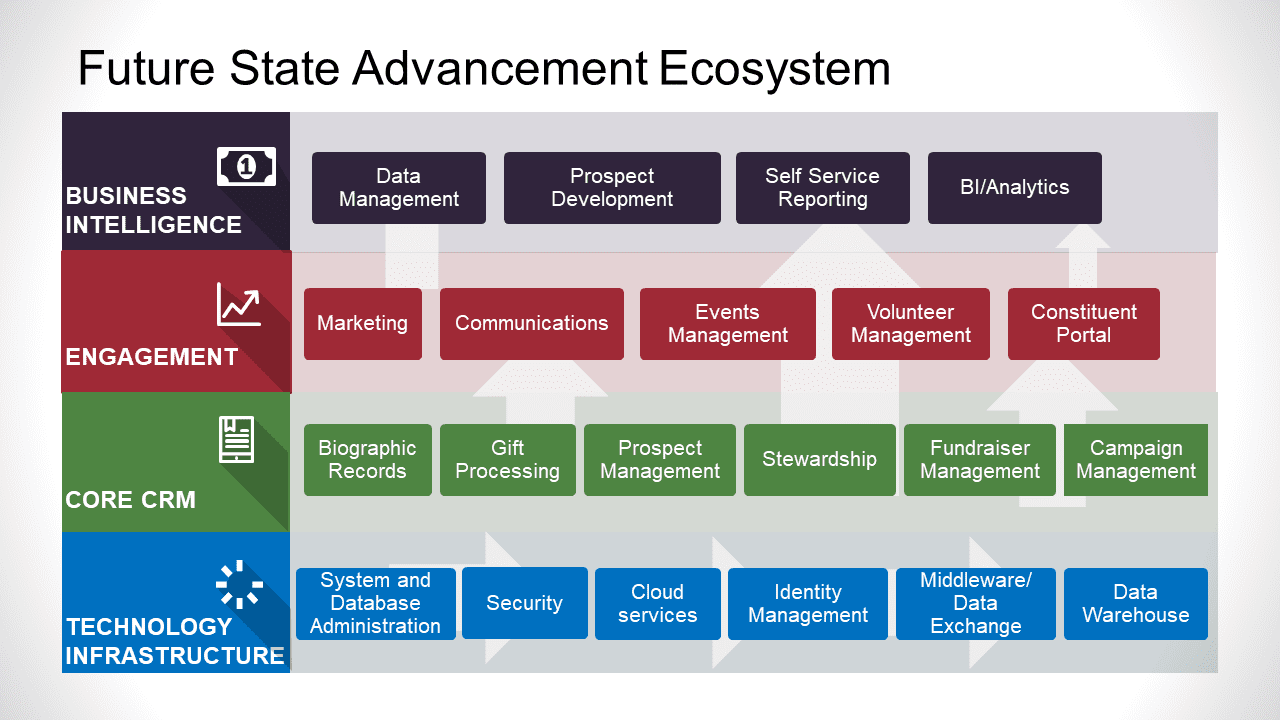Wow, a lot has changed in the world of Higher Education (and nonprofits) CRM. In particular for those institutions seeking to begin the process of selecting and implementing their next, or some might say “Next Generation” CRM. As we begin progress into 2022, it seems like many organizations are thinking about their outdated CRM – specifically, those used for Advancement, by the Foundations, Alumni Associations, and related professionals.
Whether this gnawing feeling is triggered by your recent end of a campaign or you simply know that you and your team have outgrown your current technology, this is a topic that is top-of-mind for most institutions (and non-profits alike).
Let’s be authentic – your institution needs to engage alumni in a personalized and contemporary manner. And if you don’t, another organization or cause will engage with them in a manner that might cause them to participate more with them, than with you.
Based on what we consistently hear, organizations fall into 1 of 3 categories:
- Have, in the past few years, converted to a new system
- Are in the process of implementing their new system
- Watching those intuitions in groups 1 and 2 to see how they are faring
We are in a most remarkable time and space for advancement systems – unlike I’ve ever seen. Perhaps because one of the major CRM vendors is announcing “end of life” for their system. Or perhaps, with the promise of new, cloud-based systems, many organizations are giving serious thought to replacing their aging systems that are often 20+ years old.
The problem is there are not a lot of options. The landscape is further complicated by a workforce, which expects everything to be Amazon-like in its delivery – easy to use, seamless, requires no training. As a result, we have little patience for anything else. At the same time, we are asking our advancement systems to be more than just a “system of record”. Our systems need to personalize outgoing communications, provide meaningful data for decision making, all while being as efficient as possible.
Today, there is a clash of viewpoints regarding an age-old question in the advancement world. The core database, is a system of record for biographic information, gift and pledge transactions, a repository for contact reports, correspondence, and other documentation. What’s exciting about today’s landscape is that you can overlay the core database with a whole host of tools. This helps with personalization, communication, segmentation, relationship management, reporting, and data analytics. These are powerful software tools to conduct business in the way in which is important to you.
One way we think of advancement system needs is in the form of Maslow’s Hierarchy of Needs:

We need basic functions like servers, internet, authentication, and security before we can think of anything else. Core data needs, such as biographic data and what is done with that biographic data, signify low engagement. Belonging needs, or beginning engagement, include gifts, pledges, and research. Esteem needs or substantive engagement involve stewardship and prospect management. Self-actualization is realized with predictive modeling and artificial intelligence that may result in increased personalization and improved engagement.
Tools overlaying a core database create an ecosystem. If you have the right integration tools, you can swap out old tools once new ones are developed, or as business needs change. Yet, as you can imagine, this means there are multiple products involved and it is common today to see products such as MuleSoft, Dell Boomi, and others move data from one application to another.
The following diagram has the nickname the “layer cake” diagram at TSI:

With this type of ecosystem, we can do more to take advantage of technology and be nimbler to react to constituent and business needs. Some vendors are doing fascinating, good work in this space. And if you are open to this type of advancement systems ecosystem, you can more readily take advantage of this exciting time in advancement.
As you have likely concluded by now, the difficulty arises in deciding which tools to employ, as well as in what order. You also must decide which ones are best aligned with your needs, culture, budget, and current challenges. TSI can help you articulate the problem, objectively assess the business case, help evaluate and select a new system, as well as manage the implementation. Since so many other consulting firms have a relationship with software vendors, it is very important to be discerning, comprehensive, and forward-looking while selecting external help. Please give us a call; we’d love to be a resource for your team. Contact us!
